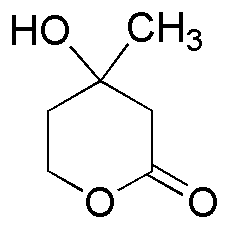(±)-Mevalonolactone is widely utilized in research focused on
- Biochemical Research: It serves as a key intermediate in the biosynthesis of terpenes and steroids, making it essential for studies in metabolic pathways.
- Pharmaceutical Development: This compound is used in the synthesis of various drugs, particularly those targeting cholesterol metabolism, offering potential benefits in treating cardiovascular diseases.
- Biotechnology: It plays a role in the production of biofuels and bioplastics, contributing to sustainable practices in the industry.
- Food Industry: As a flavoring agent, it enhances the taste profile of certain food products, appealing to manufacturers looking to improve product quality.
- Cosmetic Formulations: Its antioxidant properties make it valuable in skincare products, helping to protect skin from oxidative stress and improve overall skin health.
General Information
Properties
Safety and Regulations
Applications
(±)-Mevalonolactone is widely utilized in research focused on
- Biochemical Research: It serves as a key intermediate in the biosynthesis of terpenes and steroids, making it essential for studies in metabolic pathways.
- Pharmaceutical Development: This compound is used in the synthesis of various drugs, particularly those targeting cholesterol metabolism, offering potential benefits in treating cardiovascular diseases.
- Biotechnology: It plays a role in the production of biofuels and bioplastics, contributing to sustainable practices in the industry.
- Food Industry: As a flavoring agent, it enhances the taste profile of certain food products, appealing to manufacturers looking to improve product quality.
- Cosmetic Formulations: Its antioxidant properties make it valuable in skincare products, helping to protect skin from oxidative stress and improve overall skin health.
Documents
Safety Data Sheets (SDS)
The SDS provides comprehensive safety information on handling, storage, and disposal of the product.
Product Specification (PS)
The PS provides a comprehensive breakdown of the product’s properties, including chemical composition, physical state, purity, and storage requirements. It also details acceptable quality ranges and the product's intended applications.
Certificates of Analysis (COA)
Search for Certificates of Analysis (COA) by entering the products Lot Number. Lot and Batch Numbers can be found on a product’s label following the words ‘Lot’ or ‘Batch’.
*Catalog Number
*Lot Number
Certificates Of Origin (COO)
This COO confirms the country where the product was manufactured, and also details the materials and components used in it and whether it is derived from natural, synthetic, or other specific sources. This certificate may be required for customs, trade, and regulatory compliance.
*Catalog Number
*Lot Number
Safety Data Sheets (SDS)
The SDS provides comprehensive safety information on handling, storage, and disposal of the product.
DownloadProduct Specification (PS)
The PS provides a comprehensive breakdown of the product’s properties, including chemical composition, physical state, purity, and storage requirements. It also details acceptable quality ranges and the product's intended applications.
DownloadCertificates of Analysis (COA)
Search for Certificates of Analysis (COA) by entering the products Lot Number. Lot and Batch Numbers can be found on a product’s label following the words ‘Lot’ or ‘Batch’.
*Catalog Number
*Lot Number
Certificates Of Origin (COO)
This COO confirms the country where the product was manufactured, and also details the materials and components used in it and whether it is derived from natural, synthetic, or other specific sources. This certificate may be required for customs, trade, and regulatory compliance.


